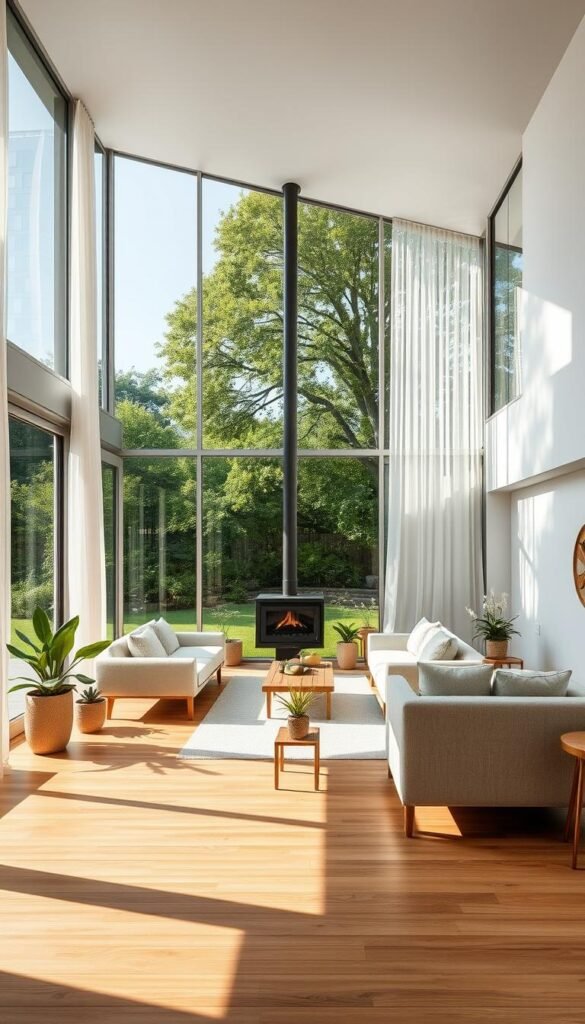Imagine stepping into a space where fresh air mingles with cozy interiors, and sunlight dances across every room. More homeowners are prioritizing this balance, merging their living spaces with natural surroundings to create serene environments.
Why does this trend resonate so deeply? It’s about redefining how you interact with your home. Expansive windows frame picturesque views, while open layouts let breezes flow freely. These choices don’t just look stunning—they transform daily life into a calming retreat.
Practicality meets beauty here. Sliding doors become portals to private gardens, and weather-resistant materials ensure durability without sacrificing style. Whether you’re hosting friends or enjoying quiet mornings, the connection to nature remains effortless.
This approach works for urban lofts, suburban residences, or coastal properties. You’ll discover how smart design choices—like strategic lighting or flexible furniture—can make any space feel airy and inviting. Let’s explore how to craft your personal sanctuary.
Welcome to Your Indoor-Outdoor Paradise
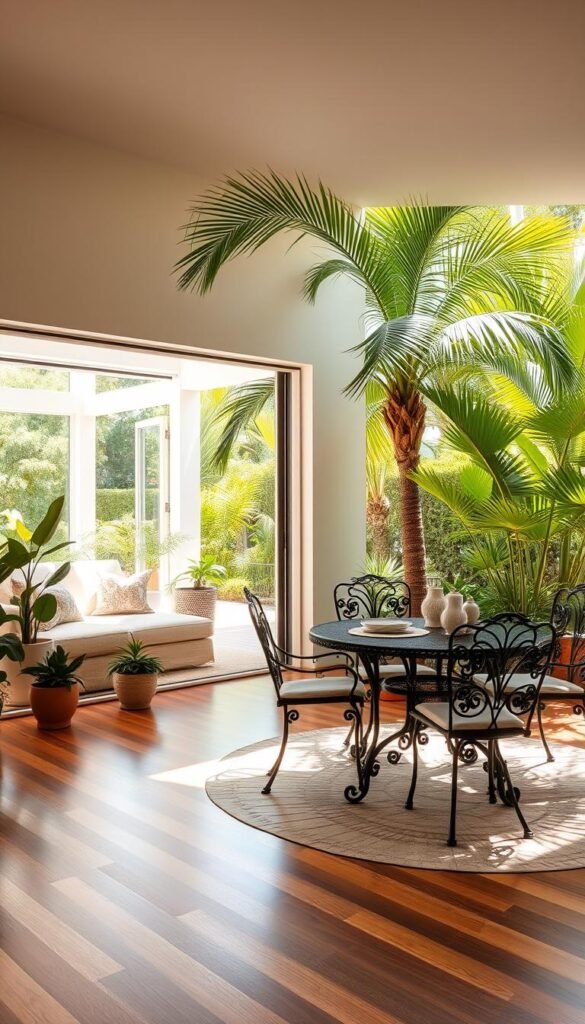
Your home becomes a gateway to nature when indoor comfort merges with outdoor vitality. Architects now craft residences where glass walls dissolve barriers, letting greenery become part of your daily rhythm.
Understanding the Modern Living Concept
Today’s designs prioritize connection over separation. Instead of boxy rooms, you’ll find airy layouts where sunlight reaches every corner. Furniture arrangements guide movement between zones, making your entire property feel unified.
The Benefits of Seamless Transitions
Open sightlines do more than look pretty—they boost mood and energy. Studies show spaces blending natural elements reduce stress by 28%*. You’ll enjoy better airflow and adaptable areas for work or relaxation.
| Traditional Design | Modern Approach | Key Advantage |
|---|---|---|
| Separate rooms | Zoned living spaces | Flexible use |
| Single-purpose furniture | Multi-functional pieces | Space efficiency |
| Limited natural light | Strategic window placement | Energy savings |
This philosophy works whether you’re redesigning a studio apartment or a suburban residence. Materials like tempered glass and composite decking bridge your interior with patios effortlessly.
House with Garden Aesthetic: Seamless Indoor-Outdoor Decorating Inspiration
Think of a design that erases boundaries, inviting the outdoors to refresh your interiors. This approach isn’t limited to sprawling properties—it adapts to apartments, townhouses, or rural cottages. By focusing on versatile elements, you craft spaces that breathe with life.
Why This Look is Perfect for Your Home
Whether your style leans modern farmhouse or mid-century, blending nature into your decor adds timeless appeal. Vertical planters or compact herb gardens bring greenery to balconies, while large mirrors amplify light in cozy rooms. It’s about working with what you have.
Urban dwellers gain private oases through smart solutions like foldable patio furniture or hanging gardens. These touches make even 500 square feet feel expansive. Meanwhile, suburban homes use covered patios as year-round extensions of their kitchens.
| Challenge | Solution | Result |
|---|---|---|
| Limited square footage | Multi-level planters | Vertical greenery |
| Low natural light | Reflective surfaces | Brighter spaces |
| Rigid layouts | Modular seating | Flexible entertaining |
This aesthetic boosts property value—79% of buyers pay premiums for outdoor living areas*. You’ll also enjoy mental health benefits from daily nature immersion. Morning coffee tastes better when sipped beside blooming window boxes.
Entertaining becomes effortless as guests flow between your kitchen and firepit area. The key? Choose durable materials like powder-coated steel or teak that withstand weather while looking chic.
Discovering the Essence of Indoor-Outdoor Harmony
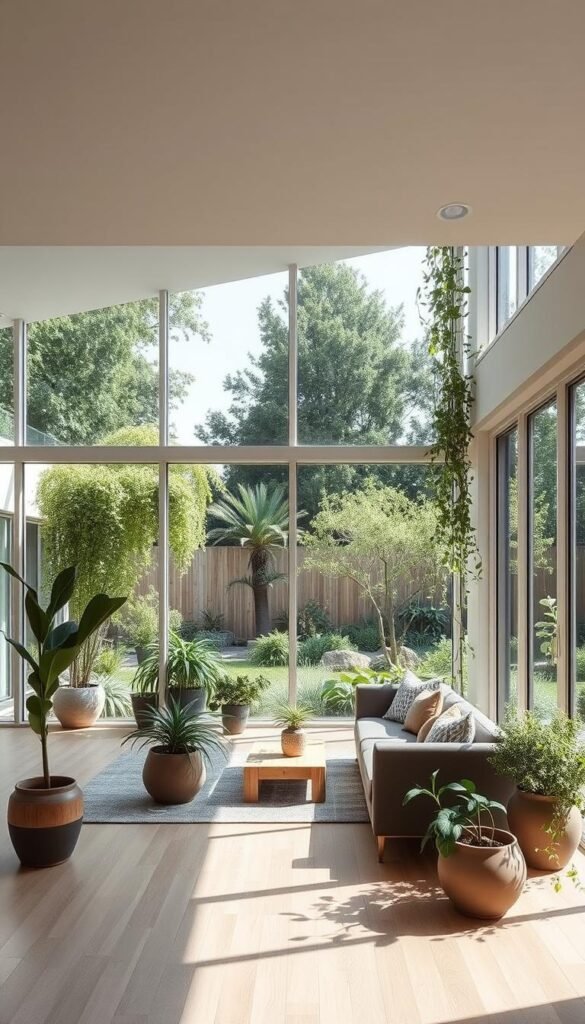
Your daily rhythm deserves spaces that move with you, not against you. True connection happens when your living spaces and outdoor retreats work in sync, like partners in a dance. It starts with observing how you use areas most—where you sip coffee, host friends, or unwind after work.
Flow Between Living Spaces and Outdoor Retreats
Position furniture to guide movement naturally. A sofa facing sliding doors draws eyes—and feet—toward the patio. Match interior flooring with deck materials to create visual momentum. These subtle cues make transitions feel intentional, not accidental.
Consider this: 63% of homeowners prioritize layouts supporting multiple activities*. Your kitchen island might extend to an alfresco dining area, while window seats become reading nooks overlooking flower beds. Elevate your gardening aesthetic by repeating pot colors indoors and out, creating unity without matchy-matchy decor.
| Traditional Approach | Harmonious Solution | Impact |
|---|---|---|
| Closed floor plans | Zoned activity areas | Better traffic flow |
| Separate color schemes | Shared accent tones | Visual continuity |
| Single-use furnishings | Convertible pieces | Space adaptability |
Lighting seals the deal. Install dimmable LEDs under eaves that mirror your interior sconces. When dusk falls, both areas glow with the same warm ambiance—proof that harmony lives in the details.
Unlocking the Potential of Living Rooms and Patios
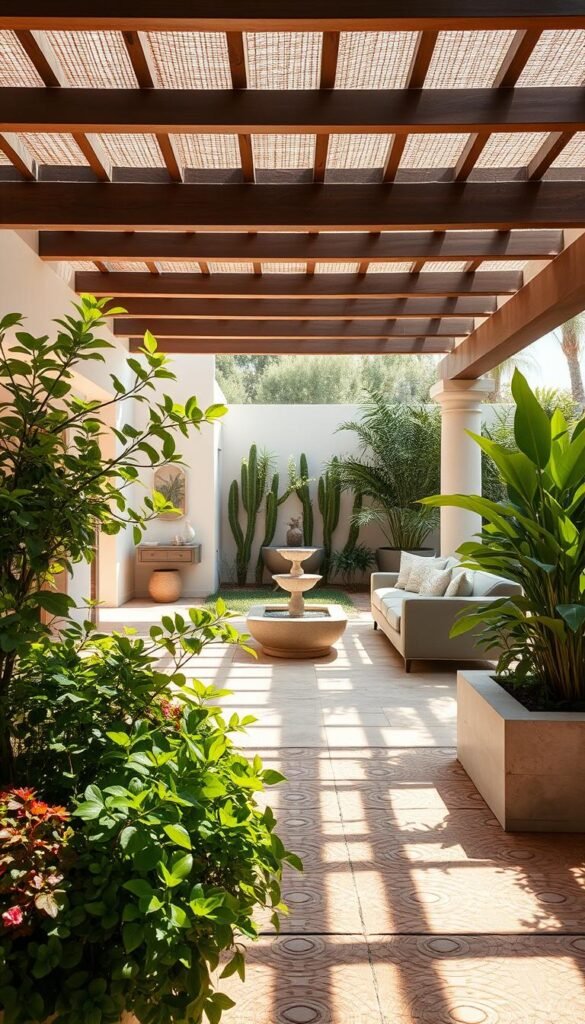
Your living room and patio are more connected than you think—when styled right, they become twin stages for daily life. By merging their functions, you create zones that adapt to quiet mornings or lively gatherings without missing a beat.
How to Create a Unified Aesthetic
Start with color stories that whisper across both spaces. A slate gray sofa indoors pairs effortlessly with matching outdoor cushions. Slatted coffee tables mirror patio planters, creating rhythm without repetition. These subtle echoes make areas feel purposefully linked.
Low-profile furniture works wonders. A sunken sectional indoors won’t block garden views, while modular ottomans serve as footrests or extra seating. Maximize space by choosing pieces that multitask—like storage benches doubling as side tables.
Maximizing Your Home’s Functionality
Portable seating transforms how you entertain. Lightweight teak benches slide from living room conversations to patio fire pits in seconds. Foldable armchairs let you expand seating where needed, rain or shine.
For year-round use, select fabrics that laugh at weather changes. Sunbrella-covered cushions stay vibrant outdoors but look equally chic beside your fireplace. Explore smart indoor-outdoor living ideas to discover pieces that thrive in both worlds.
Innovative Ways to Maximize Natural Light and Fresh Air
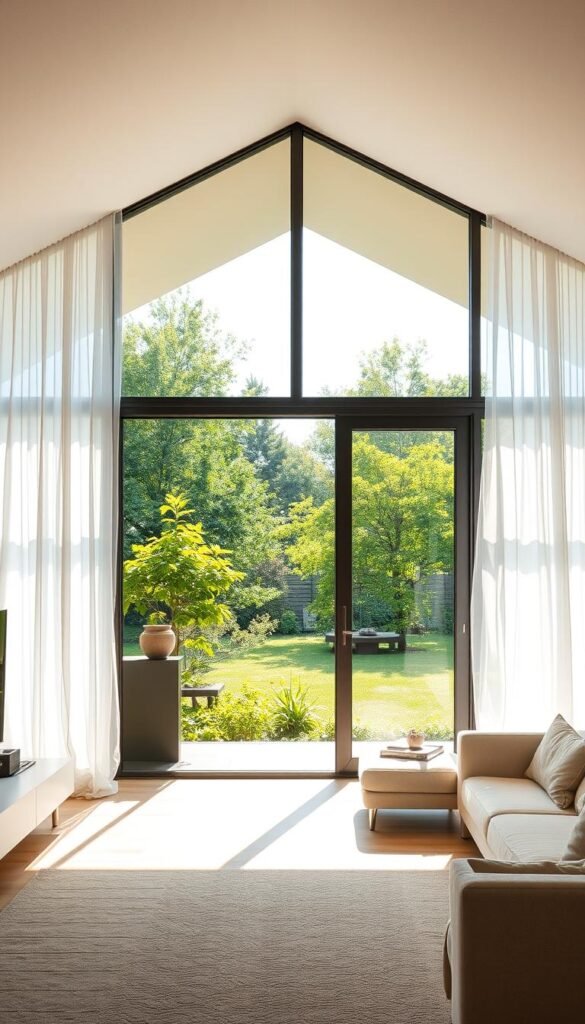
Transform your home into a sunlit sanctuary where every breeze feels like an invitation. Strategic placement of glass doors and large windows dissolves barriers between rooms and nature, creating airy spaces that energize your daily routine.
Architectural Elements That Redefine Space
Floor-to-ceiling pocket doors steal the show in modern layouts. When fully opened, they disappear into walls—flooding interiors with natural light while merging living rooms with pool decks or flower beds. Coastal homes use this trick to frame ocean vistas like moving paintings.
| Window/Door Type | Best Use | Airflow Impact |
|---|---|---|
| Bi-fold glass doors | Dining areas | Full-width ventilation |
| Corner windows | Reading nooks | Cross-breezes |
| Sliding panels | Compact patios | Adjustable openings |
Position windows opposite each other to create natural wind tunnels. This simple hack reduces AC use by 23%* during mild seasons. For privacy without sacrificing fresh air, try frosted lower panes paired with clear upper sections.
Don’t forget height matters. Install transom windows above standard ones to pull in afternoon sunlight while maintaining wall space. Your rooms will glow without feeling like a greenhouse at noon.
Material Choices: Stone, Glass, and Wood for Elegant Interiors
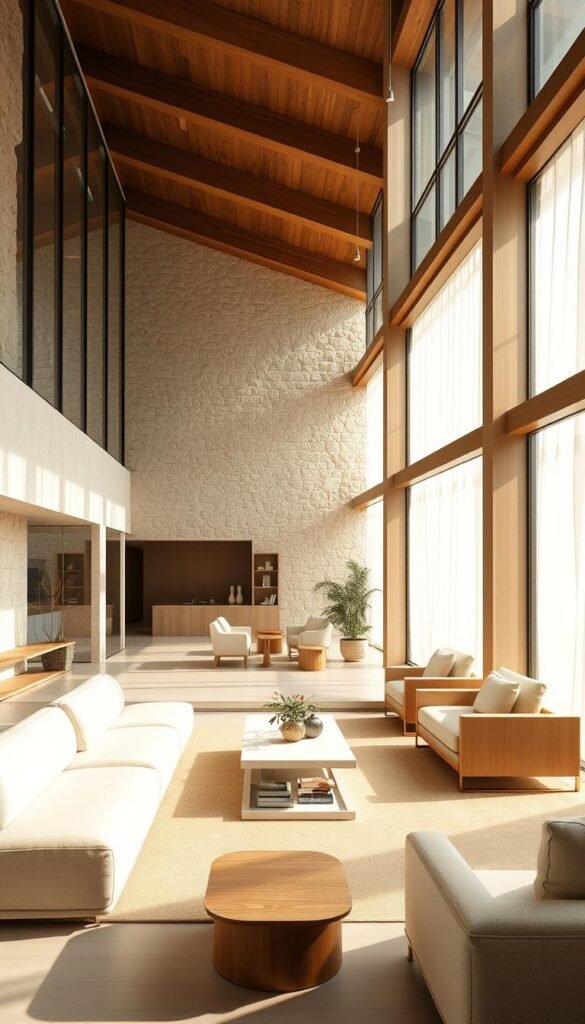
The right materials turn your space into a timeless sanctuary, blending strength with beauty. Coastal homes thrive with plaster walls and natural stone accents that resist salty air. Desert properties shine with nautical-grade metal cabinets and quartz counters built to handle harsh sunlight.
Rift-sawn oak warms expansive rooms while mirroring outdoor textures. Pair it with board-formed concrete fireplaces for earthy contrast. These choices create visual harmony between your interior design and garden vistas without shouting for attention.
| Material | Best Use | Key Benefit |
|---|---|---|
| Natural stone walls | Coastal entryways | Salt-resistant |
| Frosted glass partitions | Desert patios | Heat diffusion |
| Teak floorboards | High-traffic zones | Scratch-proof |
Graphic tile “rugs” add flair to covered porches while surviving rain or snow. Indoors, they anchor seating areas with bold patterns. This duality makes materials like quartz and powder-coated steel heroes of transitional spaces.
Balance sleek surfaces with rough-hewn textures for depth. Smooth concrete floors might flow into pebbled pathways, while glass tabletops reflect rugged stone walls. Your home becomes a curated gallery of elements that age gracefully.
Seamless Indoor-Outdoor Flow with Strategic Design Elements
Your home’s layout can rewrite how you experience nature daily. By wrapping living zones around central courtyards, you create a gravitational pull toward fresh air and sunlight. This approach turns transitional areas into destinations rather than afterthoughts.
Open-Plan Layouts Around Courtyards
Position your kitchen island to face the courtyard’s flowering dogwood. Align dining tables with sliding doors that disappear during brunch gatherings. These choices make your outdoor space feel like another room rather than separate territory.
| Traditional Layout | Courtyard-Centric Design | Advantage |
|---|---|---|
| Closed-off kitchen | Prep areas facing greenery | Visual engagement |
| Single-direction windows | 360° garden views | Light optimization |
| Separate patio access | Direct flow from multiple rooms | Convenient use |
Urban homes particularly benefit. A 12×12 courtyard becomes an extension of your living room through strategic sightlines. You’ll find yourself reading morning emails outdoors simply because the space invites you naturally.
The Role of Sliding Doors in Enhancing Space
Modern track systems let glass panels vanish completely. When open, they triple your perceived square footage. Host 20 guests? Your living area effortlessly absorbs the courtyard without crowding.
Consider these perks:
- Stacking doors create 10-foot openings for summer parties
- Frosted options maintain privacy while bathing rooms in light
- Low-profile thresholds prevent tripping during indoor-outdoor transitions
Pair them with creative gardening ideas that make your courtyard pop year-round. You’ll discover how climbing vines on trellises complement sleek glass surfaces beautifully.
Stylish Courtyard and Garden Design Ideas
Elevate your outdoor areas by thinking upward. Compact courtyards gain new life when you shift focus from ground-level plots to vertical canvases. Clever design ideas transform blank walls into living art while keeping pathways clear for movement.
Cultivating Lush, Vertical Gardens
Wall-mounted planters let you grow herbs or succulents without sacrificing precious floor space. Pair them with trellises supporting jasmine vines—their fragrant blooms perfume the air at eye level. Tiered shelves create depth, allowing ferns to cascade beside flowering begonias.
| Vertical Component | Best Use | Visual Benefit |
|---|---|---|
| Modular wall planters | Herbs & small blooms | Geometric patterns |
| Iron trellises | Climbing roses | Romantic height |
| Floating shelves | Trailing ivy | Layered textures |
Choose plants that thrive in your courtyard’s light conditions. Mix feathery ferns with broad-leaf philodendrons for contrast. In shady spots, calatheas add tropical flair with their striped leaves.
Urban dwellers, rejoice: A 6-foot wall holds 36 plants in stacked pockets. You’ll enjoy privacy screens of greenery while maintaining room for bistro seating. For year-round interest, alternate seasonal flowers with evergreen shrubs like boxwood.
Upward-focused design tricks the eye into perceiving more openness. String lights above your vertical garden amplify this effect after dark. Suddenly, your cozy courtyard feels like a secret rooftop oasis.
Creative Layouts for a Functional Living Space
What if every meal felt like dining in your favorite park? By merging your dining area with nature’s backdrop, you craft experiences that delight all five senses. Modern homes now position tables where sunlight filters through trees or reflects off water features.
Integrating Dining Areas With Outdoor Views
Swap solid walls for retractable screens beside your eating zone. This simple shift lets breezes carry the scent of blooming herbs while you enjoy brunch. Align chairs to face garden vistas—conversations flow better when eyes rest on calming views.
Compact spaces thrive with foldable tables that extend onto patios. Use matching placemats indoors and out to create visual continuity. Weather-resistant pendant lights above both zones tie the look together, rain or shine.
Your morning coffee ritual becomes a moment of peace when sipped near floor-to-ceiling windows. Even urban apartments can achieve this effect with balcony herb gardens positioned at eye level. It’s about designing living environments that nourish body and mind equally.

